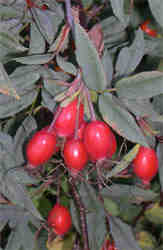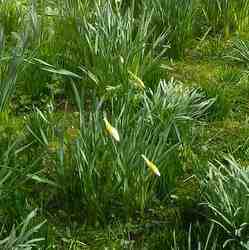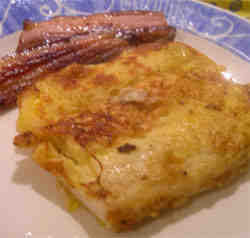Katey’s Rosehip Syrup recipe
Posted by Fiona Nevile in Cordials and Syrups | 225 comments
August rose hips in our garden
As a child this delight and a daily spoonful of rosehip syrup heralded the start of winter. At home we queued up, in order of age, as my mother doled out the syrup from a small bottle. She called it medicine. I’m sure that this is why it took me ages, as an adult, to consider trying rosehip syrup again. I discovered that homemade rosehip syrup is delicious and worth making. It is a good natural source of vitamin C. It also contains vitamins A, D and E, and antioxidants.
We have two large rose bushes growing on the east wall at the back of the cottage, that produce hundreds of hips each year. We use these to make apple and rosehip jelly in October. When the hips are softened by November frosts, we make syrup. Lots of it. We give a few bottles away to friends who are laid up with bad colds but most of our giant batch is guzzled by us throughout the winter. It tastes too good to be earmarked solely for the sick bed. Danny loves it stirred into creamy yoghurt or swirled over some home made vanilla ice cream. Somewhere in the barn, a demijohn of rosehip wine is still fermenting from last autumn.
If you don’t have roses in your garden there are lots of briar roses in the hedgerows. They are difficult to spot from a car so if you are somewhere rural and have half an hour to spare, it’s well worth walking or cycling along a footpath or a quiet country lane to see what you can find. Try and avoid busy roads as the fruit will have been exposed to exhaust fumes and nasties. Keep a couple of carrier bags in your coat pocket, just in case.
This recipe was given to me by my friend Katey. It is similar to the recipe given out by The Ministry of Food during WW2, although their’s has more sugar. She remembers being frogmarched to pick hips for rosehip syrup as a child. This didn’t put her off, she still makes it today.
Katey’s Rosehip Syrup recipe
Ingredients:
- 4.5 pts of water
- 2 lbs of rosehips
- 1lb of white granulated sugar
Method:
- There is no need to top and tail the rosehips if the liquid is going to be strained through a muslin bag. If you are using a steam juicer, pass the liquid through muslin – it will only take a few minutes.
- Bring 3 pts of water to the boil.
- Mince the rosehips through a course profile mincer (or food processor).
- Transfer the fruit into fast boiling water and bring to the boil again. Remove from heat and leave for 15 minutes.
- Pour through a sterilised jelly bag/or muslin square (how do I sterilise a jelly bag or muslin square? See Tips and tricks below) and allow the majority of the liquid to drip through.
- Return the pulp to the pan and add 1.5 pts of fresh boiling water and bring to the boil. Remove from heat and leave for 15 minutes.
- Strain through the jelly bag again.
- Pour extracted liquid into a clean saucepan and boil to reduce the liquid to 1.5 pts.
- Add the sugar and boil rapidly fro another 5 minutes. Pour into hot sterile bottles and seal immediately. (How do I sterilise bottles? See Tips and tricks below).
Tips and tricks:
- Use small bottles (we use recycled vinegar bottles) as it only keeps for a week or so once opened. If you don’t want to use bottles the syrup can be frozen in cubes.
- How do I sterilise a jelly bag or muslin square?
Both can be scalded with boiling water. If you are using a clean muslin bag or square you can iron them with a hot iron. This also works with tea cloths.
- How do I sterilise bottles?
The sterilising method that we used is simple. Just before making the syrup, I quickly wash and rinse the bottles and place them upside down in a cold oven. Set the temperature to 160? (140? fan-assisted). When the oven has reached the right temperature I turn off the heat. The bottles will stay warm for quite a while. sterilise the lids by boiling these for a few minutes in water.
Leave a reply







Hi, just tried my first batch, but it’s still really runny (basically like water!). Do I just need to boil for longer? and not much taste to it?
Should the liquid be syrup mine is very watery
I am using Rosehips picked from the beech they are big and fat, are these ok for the syrup
I guess its not best to pick until November like you said? I have just spotted some near me in a park, but wondering whether they will still be there in a month!
Leave some for the birds that over-winter here. I usually take only a quarter of what’s on the rose bushes.
I make this for various friends. Last year I added a teaspoon of powdered cinnamon to the finished syrup and that went down very well indeed!
I make rosehip syrup every year and have always used the Dog Rose type but just wonder if it is ok to use the more round type Beach Rose.
hi,
do you leave all the prickly seeds in while you do this recipe ,
and if so dont those awfully iritating hairy bits amongst the seeds
get into the syrup
cheers Ros
Hi, just tried my first batch, but it’s still really runny (basically like water!). Do I just need to boil for longer?
Doesn’t heat destroy vitamin c???!
Good question, Linda, and I’m afraid the answer must be yes. I wonder too why so much water is used; limiting it to just enough to cover the fruit will requires a lot less boiling, giving the vitamins a better chance of surviving, and will also cost less in fuel. Adding more water with no apparent purpose other than to boil it off later, offends both my engineering and environmental sensibilities. A more effective method might be to just soak the fruit overnight, then nuke it in the microwave (with a lid on; Pyrex dishes are ideal for this) and then put it through a blender before straining. Lastly, is the sugar really necessary? If you just want to thicken it, how about adding gelatin?
I imagine the hips by themselves to be quite sour – rose hip tea is quite tart – so some sugar would be necessary. Adding sugar & reducing (boiling off water) is an age old method of preserving & is what thickens it up so while just using less water to start with would produce the same amount in the end, the consistency would be, well, just like water. I guess gelatin would be an option for anyone who’s not vegetarian or vegan. I am, so not for me. And of course the sugar also preserves – it’s age old tried & tested so not sure it’s broke really… Have you experimented with your ideas? Be good to know if you get any interesting results. Altho’ as I said, gelatin is not for me…
Why try and mess around with age old recipes that actually work. I agree that the double boiling seems extreme. I do boil my rosehips to start with just to break them down as I don’t mince them. I them use a fruit steamer to extract all the juice at really high temperature which helps with the preserving. I accept we must be losing some of the Vitamin C content as with any form of cooking and I would have thought blasting anything is a Microwave was just about the most destructive method imaginable. I’ll stick to the older methods until it can be proved faulty and I’ve been making this for many years.
I also make Rosehip Jelly by adding apples to the recipe which creates enough pectin to achieve a perfect setting jelly. For me there is nothing like Rosehips to beat the flavour….with the exception maybe of Medlars.
I too use smaller bottles, but have only once had a problem with it going off. Since then I’ve always kept it in the fridge after opening and have had no difficulty at all. When preparing it’s good to remember that the burst pods make a very effective itching powder… try not to get it on your skin!